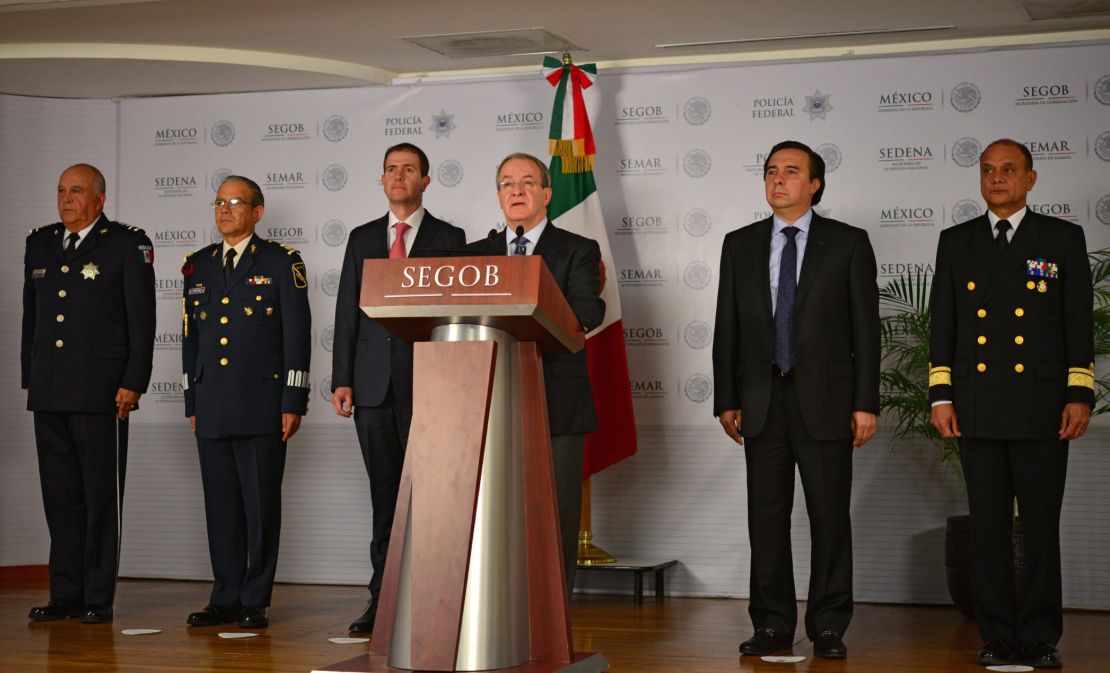Read this story in Spanish at CNNMexico.com
Story highlights
Mexican authorities say they killed cartel leader Nazario Moreno Gonzalez
Officials had already trumpeted his death in 2010 after a shootout
This time, authorities say they have the body and fingerprints confirm it
Moreno was known for his "dangerousness," authorities say
It’s deja vu, drug lord style.
Mexican authorities say they gunned down notorious cartel leader Nazario Moreno Gonzalez on Sunday.
By most measures, it sounds like a major victory in the government’s fight against organized crime. But there’s a catch.
He was supposed to be dead already.
In 2010, then-Mexican President Felipe Calderon’s government trumpeted Moreno’s death, announcing that he’d been killed after two days of shootouts between armed forces and criminals.
Officials revealed a surprising twist on Sunday, announcing the 2010 report of his death was inaccurate.
Monte Alejandro Rubido Garcia, executive secretary of Mexico’s National Public Security System, said Moreno was very much alive when federal troops cornered him on Sunday. They planned to arrest him, Rubido said, but Moreno was fatally shot after he opened fire.
For years, rumors have swirled about Moreno. Critics said the Mexican government had never proven that Moreno had been slain after the 2010 announcement.
Federal authorities initially said they couldn’t provide physical evidence because Moreno’s body had been collected by fellow cartel members after clashes.
In 2011, state prosecutors acknowledged they’d never recovered Moreno’s body and couldn’t confirm he was dead.
“We’ve never found a body, fingerprints, photographs,” George W. Grayson, a Mexico expert at the College of William and Mary, told CNN that year. “We know his burial site, but no one has exhumed the body. There are a lot of questions.”
Authorities received numerous reports that Moreno remained alive, Rubido said Sunday,
On Sunday, Mexican authorities said fingerprint tests had confirmed that Moreno was really the one they killed this time, but they were still awaiting DNA test results.
Cartel founder ‘known for his dangerousness’
Moreno – nicknamed “The Craziest One,” “El Chayo” and “The Doctor” – was “known for his dangerousness,” Rubido said Sunday.
He was a founder of La Familia Michoacana, a cartel that started in the western Mexican state of Michoacan and grabbed national attention in 2006 after reportedly hurling five decapitated heads of rival gang members onto a dance floor.

The group began splintering soon after authorities announced Moreno’s death in 2010, and a similar spinoff organization known as the Knights Templar effectively took La Familia’s place as the dominant group in the region.
The Knights Templar has increasingly found itself in the Mexican government’s cross-hairs in recent months as citizen self-defense militias in Michoacan pressured authorities to crack down on the cartel and capture Moreno, who they claimed was still alive and leading the group.
On Sunday, Mexican officials described his death as “the most important blow to the criminal group that he headed” and said he was “the undisputed leader of the criminal group that dominates the state,” but didn’t mention the group’s name.
Toning down the rhetoric about drug cartels has been part of Mexican President Enrique Peña Nieto’s security strategy since he took office in December 2012.
Authorities have largely stopped parading suspects before cameras after high-profile arrests and seem to be making an effort to avoid actions that could be seen as glorifying cartels.
‘Spiritual leader’
A Mexican government dossier released in 2010 described Moreno as the brains behind many killings. Authorities said he was a self-fashioned “spiritual leader” who used religion to recruit criminals and strengthen his stronghold.
But he started small. As a teenager, he was a migrant worker in the United States and worked in several locations in California, the profile said. He was arrested for the first time on drug trafficking charges in McAllen, Texas, in 1994.
“Moreno started as a migrant in California, continued trafficking marijuana on the border and became the leader of one of the most violent criminal organizations in the history of Mexico,” the report said.
In Mexico, Moreno dubbed himself the “savior of the people” and crafted La Familia’s philosophy, outlined in a “bible” provided to new recruits.
La Familia’s approach showed a “strong religious background,” the U.S. Drug Enforcement Administration said in 2009.
“It purportedly originated to protect locals from the violence of drug cartels. Now, La Familia Michoacana uses drug proceeds to fuel their agenda that encompasses a Robin Hood-type mentality – steal from the rich and give to the poor,” the DEA said. “They believe they are doing God’s work, and pass out Bibles and money to the poor. La Familia Michoacana also gives money to schools and local officials.”
In 2011, the Knights Templar announced its presence and took a similar approach, with banners hanging in prominent locations vowing to protect residents of Michoacan.
“Our commitment to society will be to preserve order and prevent robbery, kidnapping and extortion, and protect the state from interventions by rival organizations,” the signs said.
In a raid aimed at cracking down on the new cartel that year, Mexican police seized white robes emblazoned with bright red crosses and handbooks outlining a code for the Knights Templar.
Analysts have long pointed to such finds as a sign that the Knights Templar also used religion to recruit and retain members.
The legend of ‘El Chapo’: Cartel chief cultivated Robin Hood image
CNN’s Elwyn Lopez contributed to this report.






